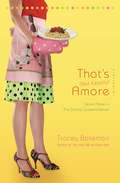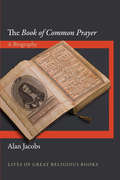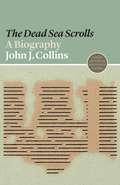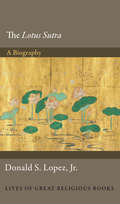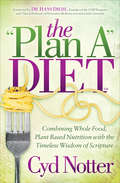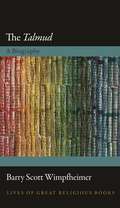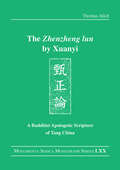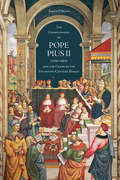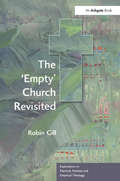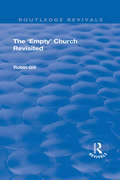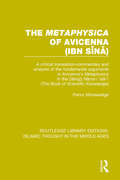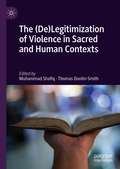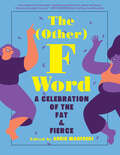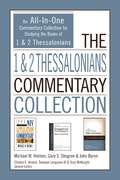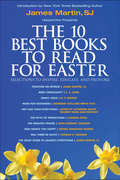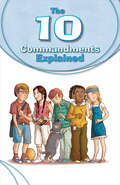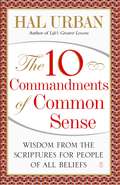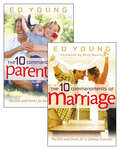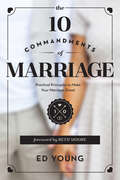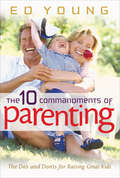- Table View
- List View
That's: A Novel (Drama Queens #3)
by Tracey BatemanWhen Laini Sullivan lands a job designing Nick Pantalone's coffee shop, there are two problems: one, Nick's nephew Joe hates all of her ideas and two, Laini has to admit he's right--she's a disaster at design. Still, she can't risk losing the job. To compromise, Joe brings in help on the project, while Laini continues to bake the goodies that keep his customers lining up. Their relationship is moving along, so when new guy Officer Mark Hall implies that Joe's family is tied to the mob, Laini doesn't want to believe it. But things spin out of control when she meets the family, including "the uncles," who seem to confirm Mark's suspicions. To make things worse, Nana Pantalone makes it clear Laini isn't the kind of girl she has in mind for her grandson. Laini's not sure if she should give Joe the benefit of the doubt or just set her sites on Mark and fuhgetaboutit.
The "Book of Common Prayer"
by Alan JacobsWhile many of us are familiar with such famous words as, "Dearly beloved, we are gathered together here. . ." or "Ashes to ashes, dust to dust," we may not know that they originated with The Book of Common Prayer, which first appeared in 1549. Like the words of the King James Bible and Shakespeare, the language of this prayer book has saturated English culture and letters. Here Alan Jacobs tells its story. Jacobs shows how The Book of Common Prayer--from its beginnings as a means of social and political control in the England of Henry VIII to its worldwide presence today--became a venerable work whose cadences express the heart of religious life for many.The book's chief maker, Thomas Cranmer, Archbishop of Canterbury, created it as the authoritative manual of Christian worship throughout England. But as Jacobs recounts, the book has had a variable and dramatic career in the complicated history of English church politics, and has been the focus of celebrations, protests, and even jail terms. As time passed, new forms of the book were made to suit the many English-speaking nations: first in Scotland, then in the new United States, and eventually wherever the British Empire extended its arm. Over time, Cranmer's book was adapted for different preferences and purposes. Jacobs vividly demonstrates how one book became many--and how it has shaped the devotional lives of men and women across the globe.
The "Dead Sea Scrolls"
by John J. CollinsSince they were first discovered in the caves at Qumran in 1947, the Dead Sea Scrolls have aroused more fascination--and more controversy--than perhaps any other archaeological find. They appear to have been hidden in the Judean desert by the Essenes, a Jewish sect that existed around the time of Jesus, and they continue to inspire veneration and conspiracy theories to this day. John Collins tells the story of the bitter conflicts that have swirled around the scrolls since their startling discovery, and sheds light on their true significance for Jewish and Christian history. Collins vividly recounts how a Bedouin shepherd went searching for a lost goat and found the scrolls instead. He offers insight into debates over whether the Essenes were an authentic Jewish sect and explains why such questions are critical to our understanding of ancient Judaism and to Jewish identity. Collins explores whether the scrolls were indeed the property of an isolated, quasi-monastic community living at Qumran, or whether they more broadly reflect the Judaism of their time. And he unravels the impassioned disputes surrounding the scrolls and Christianity. Do they anticipate the early church? Do they undermine the credibility of the Christian faith? Collins also looks at attempts to "reclaim" the scrolls for Judaism after the full corpus became available in the 1990s, and at how the decades-long delay in publishing the scrolls gave rise to sensational claims and conspiracy theories.
The "Lotus Sūtra": A Biography
by Donald S. Lopez Jr.The Lotus Sutra is arguably the most famous of all Buddhist scriptures. Composed in India in the first centuries of the Common Era, it is renowned for its inspiring message that all beings are destined for supreme enlightenment. Here, Donald Lopez provides an engaging and accessible biography of this enduring classic.Lopez traces the many roles the Lotus Sutra has played in its travels through Asia, Europe, and across the seas to America. The story begins in India, where it was one of the early Mahayana sutras, which sought to redefine the Buddhist path. In the centuries that followed, the text would have a profound influence in China and Japan, and would go on to play a central role in the European discovery of Buddhism. It was the first Buddhist sutra to be translated from Sanskrit into a Western language--into French in 1844 by the eminent scholar Eugène Burnouf. That same year, portions of the Lotus Sutra appeared in English in The Dial, the journal of New England's Transcendentalists. Lopez provides a balanced account of the many controversies surrounding the text and its teachings, and describes how the book has helped to shape the popular image of the Buddha today. He explores how it was read by major literary figures such as Henry David Thoreau and Gustave Flaubert, and how it was used to justify self-immolation in China and political extremism in Japan.Concise and authoritative, this is the essential introduction to the life and afterlife of a timeless masterpiece.
The "Plan A" Diet: Combining Whole Food, Plant Based Nutrition with the Timeless Wisdom of Scripture
by Cyd Notter&“A great blueprint for changing your life . . . This book provides food for the body and for the soul.&” —Pamela A. Popper, PhD, ND, author of Food Over Medicine By combining her decades-long study of both nutrition and scripture, Cyd Notter has created The &“Plan A&” Diet to serve as a message of hope to those who are nutritionally confused, suffer with declining health, or continually flit from one failed diet plan to another. The book provides a simple, achievable answer for permanent weight loss and improved health, as well as useful insights for dealing with resistance to change. Research confirms that plant-based nutrition is more powerful in restoring health than drugs or surgery, and is proven to be the only diet capable of reversing our number one killer: heart disease. Readers ready to take an active role in their health are equipped with a meal plan, tips for evaluating conflicting information, and an optional transition strategy. Prayer and biblical support has also been included to encourage people of faith. By correlating today&’s unbiased science with the wisdom of applicable scripture, the book illustrates why God&’s first prescribed diet for mankind—His &“Plan A&” Diet—remains the ideal food to this day.
The "Talmud": A Biography (Lives of Great Religious Books #28)
by Barry Scott WimpfheimerThe life and times of an enduring work of Jewish spiritualityThe Babylonian Talmud, a postbiblical Jewish text that is part scripture and part commentary, is an unlikely bestseller. Written in a hybrid of Hebrew and Aramaic, it is often ambiguous to the point of incomprehension, and its subject matter reflects a narrow scholasticism that should hardly have broad appeal. Yet the Talmud has remained in print for centuries and is more popular today than ever. Barry Scott Wimpfheimer tells the remarkable story of this ancient Jewish book and explains why it has endured for almost two millennia.Providing a concise biography of this quintessential work of rabbinic Judaism, Wimpfheimer takes readers from the Talmud's prehistory in biblical and second-temple Judaism to its present-day use as a source of religious ideology, a model of different modes of rationality, and a totem of cultural identity. He describes the book's origins and structure, its centrality to Jewish law, its mixed reception history, and its golden renaissance in modernity. He explains why reading the Talmud can feel like being swept up in a river or lost in a maze, and why the Talmud has come to be venerated--but also excoriated and maligned—in the centuries since it first appeared.An incomparable introduction to a work of literature that has lived a full and varied life, this accessible book shows why the Talmud is at once a received source of traditional teachings, a touchstone of cultural authority, and a powerful symbol of Jewishness for both supporters and critics.
The "Zhenzheng lun" by Xuanyi: A Buddhist Apologetic Scripture of Tang China (Monumenta Serica Monograph Series)
by Thomas JülchThe Zhenzheng lun 甄正論 (T 2112, Treatise of Revealing the Correct) is a Chinese Buddhist apologetic treatise with a distinct anti-Daoist stance in three juan. It is organized as a dialogue between a Daoist, the "Venerable Obstructed by Customs" (zhisu gongzi 滯俗公子), and the Buddhist "Master Revealing the Correct" (zhenzheng xiansheng 甄正先生) in which the former is gradually led towards an orthodox Buddhist understanding by the latter through the refutation of his various arguments against Buddhism. Composed in the late 7th century, the text was authored depending on the political interests and strategies of Wu Zhao武曌 (624–705), who in 690 was enthroned as Empress Wu Zetian 武則天. This study of Thomas Jülch offers a richly annotated and complete translation of the Zhenzheng lun along with an introductory part that focuses on reconstructing the political and propagandistic circumstances relevant to the understanding of the Zhenzheng lun.
The #MeToo Reckoning: Facing the Church's Complicity in Sexual Abuse and Misconduct
by Ruth Everhart2020 Publishers Weekly Book of the Year - Religion
The 'Commentaries' of Pope Pius II (1458-1464) and the Crisis of the Fifteenth-Century Papacy
by Emily O'BrienWritten in the mid-fifteenth century, Pope Pius II's Commentaries are the only known autobiography of a reigning pontiff and a fundamental text in the history of Renaissance humanism.In this book, Emily O'Brien positions Pius' expansive autobiographical text within that century's contentious debate over ecclesiastical sovereignty. Presenting the Commentaries as Pius' response to the crisis of authority, legitimacy, and relevance that was engulfing the Renaissance papacy, she shows how the Commentaries function as both an aggressive assault on the papal monarchy's chief opponents and a systematic defense of Pius's own troubled pontificate and his pre-papal career. Illustrating how the language, imagery, and ideals of secular power inform Pius' apologetic self-portrait, The Commentaries of Pope Pius II (1458-1464) and the Crisis of the Fifteenth-Century Papacy demonstrates the role that Pius and his writings played in the evolution of the Renaissance papacy.
The 'Empty' Church Revisited (Explorations in Practical, Pastoral and Empirical Theology)
by Robin GillWhen did churches start to appear more empty than full - and why? The very physicality of largely empty churches and chapels in Britain plays a powerful role in popular perceptions of 'religion'. Empty churches are frequently cited in the media as evidence of large scale religious decline. The 'Empty' Church Revisited presents a systematic account of British churchgoing patterns over the last two hundred years, uncovering the factors and the statistics behind the considerable process of decline in church attendence. Dispelling as myth the commonly held views that the process of secularization in British culture has led to the decline in churchgoing and resulted in the predominantly empty churches of today, Gill points to physical factors, economics and issues of social space to shed new light on the origins of empty churches. This thoroughly updated edition of Robin Gill's earlier work, The Myth of the Empty Church, presents new data throughout to explore afresh the paradox of church building activity in a context of decline, the patterns of urbanisation followed by sub-urbanisation affecting churches, changes in patterns of worship, and changes within the sociology of religion in the last decade.
The 'Empty' Church Revisited: On The Modern Idea Of Nationality
by Robin GillThis title was first published in 2003. When did churches start to appear more empty than full - and why? The very physicality of largely empty churches and chapels in Britain plays a powerful role in popular perceptions of 'religion'. Empty churches are frequently cited in the media as evidence of large scale religious decline. The Empty Church Revisited presents a systematic account of British churchgoing patterns over the last two hundred years, uncovering the factors and the statistics behind the considerable process of decline in church attendence. Dispelling as myth the commonly held views that the process of secularization in British culture has led to the decline in churchgoing and resulted in the predominantly empty churches of today, Gill points to physical factors, economics and issues of social space to shed new light on the origins of empty churches. This thoroughly updated edition of Robin Gill's earlier work, The Myth of the Empty Church, presents new data throughout to explore afresh the paradox of church building activity in a context of decline, the patterns of urbanisation followed by sub-urbanisation affecting churches, changes in patterns of worship, and changes within the sociology of religion in the last decade.
The 'Metaphysica' of Avicenna: A critical translation-commentary and analysis of the fundamental arguments in Avicenna's 'Metaphysica' in the 'Dānish Nāma-i 'alā'ī' ('The Book of Scientific Knowledge') (Routledge Library Editions: Islamic Thought in the Middle Ages)
by Parviz MorewedgeIn this book, first published in 1973, Professor Parviz Morewedge, an expert on Islamic philosophy and mysticism, provides a critical exposition of one text of ibn Sina (Avicenna), the great Persian philosopher who lived from 980 to 1037. The text is his Metaphysica in the Danish Nama-I ‘ala’I (The Book of Scientific Knowledge). In addition to a translation of the text from Persian into English, this edition includes a critical commentary on the major arguments found in the text, and notes and references to other texts of ibn Sina as well as to relevant texts of Greek philosophers, particularly Aristotle, Plotinus and Proclus. There is also a glossary of the key terms used in the Metaphysica, with their Persian, Arabic, Greek and Latin equivalents where necessary. This book is concerned primarily to show that although in the text ibn Sina resorts to the Aristotelian vocabulary and Neo-Platonic themes, and appears to be in accord with the Islamic tradition, there is evidence that many doctrines expressed by him may be considered non-Greek and non-Islamic. These include his peculiar doctrine of Self (nafs) and the doctrine of the Necessary Existent (wajib al-wujud). The author attempts to clarify the extent to which salient features of ibn Sina’s position are in agreement with what may be regarded as Sufic doctrines.
The 'Soul' of the Primitive
by Lucien Lévy-BruhlThe object of this book, first published in 1928, is a study of the ways in which those who were once called ‘primitives’ conceive of their own individuality. The author inquires into the notions they possess of their life-principle, their soul, and their personality, often encountering that many peoples only had ‘pre-notions’ of such concepts.
The 'Ulama in Contemporary Pakistan: Contesting and Cultivating an Islamic Republic
by Mashal SaifIn this book, Mashal Saif explores how contemporary 'ulama, the guardians of religious knowledge and law, engage with the world's first and most populated Islamic nation-state: Pakistan. In mapping these engagements, she weds rich ethnography with rigorous textual analysis and offers insight into some of the most significant and politically charged issues in recent Pakistani history. These include debates over the rights of women; the country's notorious blasphemy laws; the legitimacy of religiously mandated insurrection against the state; sectarian violence; and the place of Shi'as within the Sunni majority nation. These diverse case studies are knit together by the project's most significant contribution: a theoretical framework that understands the 'ulama's complex engagements with their state as a process of both contestation and cultivation of the Islamic Republic by citizen-subjects. This framework provides a new way of assessing state-'ulama relations not only in contemporary Pakistan but also across the Muslim world.
The (De)Legitimization of Violence in Sacred and Human Contexts
by Muhammad Shafiq Thomas Donlin-SmithThis book provides a multidisciplinary commentary on a wide range of religious traditions and their relationship to acts of violence. Hate and violence occur at every level of human interaction, as do peace and compassion. Scholars of religion have a particular obligation to make sense out of this situation, tracing its history and variables, and drawing lessons for the future. From the formative periods of the religious traditions to their application in the contemporary world, the essays in this volume interrogate the views on violence found within the traditions and provide examples of religious practices that exacerbate or ameliorate situations of conflict.
The (Other) F Word: A Celebration of the Fat & Fierce
by Angie Manfredi“This outstanding anthology of essays, illustrations, poems, and letters . . . is a celebration of every body and presents a revolutionary message” (Publishers Weekly, starred review). The time has come for fat people to tell their own stories. The (Other) F Word combines the voices of Renée Watson, Julie Murphy, Jes Baker, Samantha Irby, Bruce Sturgell, and many others in a relatable, revelatory and inspiring exploration of body image and fat acceptance. This dazzling collection of art, poetry, essays, and fashion tips is meant for people of all sizes who desire to be seen and heard in a culture consumed by a narrow definition of beauty. By combining the talents of renowned fat YA and middle-grade authors, as well as fat influencers and creators, The (Other) F Word offers teen readers and activists of all ages a tool for navigating our world with confidence and courage.
The 1 and 2 Thessalonians Commentary Collection: An All-In-One Commentary Collection for Studying the Books of 1 and 2 Thessalonians
by Tremper Longman III Scot Mcknight Clinton E. Arnold John Byron Michael W. Holmes Gary ShogrenThis 1 and 2 Thessalonians commentary bundle features volumes from the NIV Application Commentary Series, Zondervan Exegetical Commentary Series, and Story of God Bible Commentary Series authored by Michael W. Holmes, Gary S. Shogren, and John Byron. The diverse features from each of the volumes gives you all the tools you need to master the books of 1 and 2 Thessalonians.
The 10 Best Books to Read for Easter: Selections to Inspire, Educate, and Provoke
by James MartinNew York Times bestselling author James Martin, SJ, presents The 10 Best Books to Read for Easter. This free sampler is a curated volume of excerpts from new and classic titles from leading authors in the field, including C. S. Lewis, N. T. Wright, Desmond Tutu, Ann Patchett, Candida Moss, John Dominic Crossan, Father Jonathan Morris, and Thomas H. Groome. The 10 Best Books to Read for Easter: Selections to Inspire, Educate, and Provoke includes: An Introduction from James Martin, SJ And excerpts from: Together on Retreat by James Martin, SJ Mere Christianity by C. S. Lewis Simply Jesus by N. T. Wright Made for Goodness by Desmond Tutu and Mpho Tutu Not Less Than Everything by Catherine Wolff (Editor) The Worthless Servant by Ann Patchett The Myth of Persecution by Candida Moss The Greatest Prayer by John Dominic Crossan God Wants You Happy by Father Jonathan Morris Will There Be Faith? by Thomas H. Groome The Jesuit Guide to (Almost) Everything by James Martin, SJ
The 10 Commandments Explained
by Antonio Vecchini Silvia VecchiniBring children ages 8-12 into a deeper understanding of the Ten Commandments. This guide explores each of the commandments and shows children the purpose of the commandments. Each chapter explores a commandment's deeper meanings. Prayers, reflections, a notebook section and quotes from various saints and theologians give more depth to the commandments. The 10 Commandments Explained examines the commandments and gives children a more thorough understanding of what they entail, which offers them a deeper understanding of their faith and God.
The 10 Commandments of Common Sense
by Hal UrbanThe author of Life's Greatest Lessons presents ten principles of practical wisdom to live by, drawn from readings of both the Old and New Testaments for people of all beliefs. Readers love Hal Urban's books for their common sense, their wisdom, and their inspirational affirmation of timeless values. With The 10 Commandments of Common Sense, he continues to build on his central theme -- that there's a direct relationship between good character and the quality of life. He also shows how the teachings of Scripture and the genuine practice of faith can be integral parts of a fulfilling existence. Urban draws on his own lifelong spiritual search -- which has included Protestant churches, the Catholic church, some Eastern philosophies, and human potential psychology -- to produce an ecumenical and nondogmatic examination of the Scriptures, finding in them clear and simple guidance for increasing both purpose and joy in our lives. Five of his principles are do's, as in "Keep a positive outlook on life" and "Bring out the best in other people." The other five are don't's, as in "Don't be seduced by popular culture" and "Don't judge other people." These ten commandments of timeless wisdom will inspire people of all faiths who are searching for more meaning and direction in their lives, no matter where it comes from.
The 10 Commandments of Marriage/The 10 Commandments of Parenting Set
by Ed YoungThis set includes The 10 Commandments of Marriage and The 10 Commandments of Parenting.In The 10 Commandments of Marriage, Ed Young uses his decades of experience counseling couples to provide ten commandments for a lifelong marriage that sizzles. God wants your marriage to be nothing short of incredible. And it could all begin with this amazing book.In The 10 Commandments of Parenting, Ed Young draws from decades of counseling and raising his own children to help you create a biblical foundation for life's greatest challenge and most important calling. New moms and dads always have the same reaction: 'I had no idea it would be this hard!' But you can make it a little easier,and a lot more rewarding,simply by following The 10 Commandments of Parenting. The 10 Commandments of Parenting includes: 1. Thou Shalt Build a Functional Family 2. Thou Shalt Love Thy Children 3. Thou Shalt Model Godliness 4. Thou Shalt Teach Thy Children 5. Thou Shalt Spend Time With Thy Children 6. Thou Shalt Discipline Thy Children 7. Thou Shalt Encourage Thy Children 8. Thou Shalt Provide Stability and Security for Thy Children 9. Thou Shalt Have the Sex Talk With Thy Children 10. Thou Shalt Not Be a Passive Parent
The 10 Commandments of Marriage/The 10 Commandments of Parenting Set
by Ed YoungThis set includes The 10 Commandments of Marriage and The 10 Commandments of Parenting.In The 10 Commandments of Marriage, Ed Young uses his decades of experience counseling couples to provide ten commandments for a lifelong marriage that sizzles. God wants your marriage to be nothing short of incredible. And it could all begin with this amazing book.In The 10 Commandments of Parenting, Ed Young draws from decades of counseling and raising his own children to help you create a biblical foundation for life's greatest challenge and most important calling. New moms and dads always have the same reaction: 'I had no idea it would be this hard!' But you can make it a little easier,and a lot more rewarding,simply by following The 10 Commandments of Parenting. The 10 Commandments of Parenting includes: 1. Thou Shalt Build a Functional Family 2. Thou Shalt Love Thy Children 3. Thou Shalt Model Godliness 4. Thou Shalt Teach Thy Children 5. Thou Shalt Spend Time With Thy Children 6. Thou Shalt Discipline Thy Children 7. Thou Shalt Encourage Thy Children 8. Thou Shalt Provide Stability and Security for Thy Children 9. Thou Shalt Have the Sex Talk With Thy Children 10. Thou Shalt Not Be a Passive Parent
The 10 Commandments of Marriage: Practical Principles to Make Your Marriage Great
by Ed YoungMarriage is God's idea. He planned it. He designed it. And if you follow His blueprint, it will be more rewarding, more loving, more exciting than you ever imagined.In The 10 Commandments of Marriage, Dr. Ed Young shares the &“thou shalts&” and the &“thou shalt nots&” of successful relationships—straight from the pages of God's Word. Long-married couples will find love-building precepts that will revive a failing marriage and make a great relationship even better. Soon-to-be-marrieds will discover what marriage is all about and gain priceless insights into starting on solid ground.In words that are profound, often humorous, but always biblical, Dr. Young draws from decades of counseling couples to provide 10 commandments for a lifelong marriage that sizzles. God wants your marriage to be nothing short of incredible. And it could begin with this amazing book."The 10 Commandments of Marriage not only tells you 'what' but, thankfully, also tells you 'how.' Ed Young has taken the principles of Scripture and has had the courage to test them on the linoleum glued to average life on planet earth." — Beth Moore (bestselling author and speaker)
The 10 Commandments of Marriage: Practical Principles to Make Your Marriage Great
by Ed YoungMarriage is God's idea. He planned it. He designed it. And if you follow His blueprint, it will be more rewarding, more loving, more exciting than you ever imagined.In The 10 Commandments of Marriage, Dr. Ed Young shares the &“thou shalts&” and the &“thou shalt nots&” of successful relationships—straight from the pages of God's Word. Long-married couples will find love-building precepts that will revive a failing marriage and make a great relationship even better. Soon-to-be-marrieds will discover what marriage is all about and gain priceless insights into starting on solid ground.In words that are profound, often humorous, but always biblical, Dr. Young draws from decades of counseling couples to provide 10 commandments for a lifelong marriage that sizzles. God wants your marriage to be nothing short of incredible. And it could begin with this amazing book."The 10 Commandments of Marriage not only tells you 'what' but, thankfully, also tells you 'how.' Ed Young has taken the principles of Scripture and has had the courage to test them on the linoleum glued to average life on planet earth." — Beth Moore (bestselling author and speaker)
The 10 Commandments of Parenting: The Do's and Don'ts for Raising Great Kids
by Ed YoungNew moms and dads always have the same reaction: 'I had no idea it would be this hard!' But you can make it a little easier,and a lot more rewarding,simply by following The 10 Commandments of Parenting. In words that are clear, simple, and sometimes humorous, Ed Young draws from decades of counseling and raising his own children to help you created a biblical foundation for life's greatest challenge and most important calling.The 10 Commandments of Parenting includes: 1. Thou Shalt Build a Functional Family 2. Thou Shalt Love Thy Children 3. Thou Shalt Model Godliness 4. Thou Shalt Teach Thy Children 5. Thou Shalt Spend Time With Thy Children 6. Thou Shalt Discipline Thy Children 7. Thou Shalt Encourage Thy Children 8. Thou Shalt Provide Stability and Security for Thy Children 9. Thou Shalt Have the Sex Talk With Thy Children 10. Thou Shalt Not Be a Passive Parent
